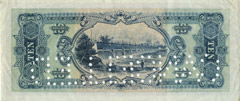History of Banknotes
Early Days
The first Australian banknotes were only produced a century ago but currency existed in Australia well before then. For instance Aboriginal trade was based on exchange and bartering, and when New South Wales was first established, colonists initially used other makeshift currencies such as rum.
The discovery of gold in 1851 led to the minting of Australia's own gold coins and spurred the development of banking. Commercial banks issued their own notes backed by gold, though people were often wary of them particularly after many banks failed in 1893. The Queensland Treasury also issued their own legal tender banknotes and prohibited private banks in the state from issuing their own notes.
The passing of the Australian Notes Act of 1910, which assigned responsibility for the issue of banknotes to the Commonwealth Treasury, however, made it an offence for any bank to circulate banknotes issued by a State and withdrew their status as legal tender. Further, the issuing of banknotes by private banks was effectively discouraged by the Bank Notes Tax Act, also of 1910, which imposed a tax of 10 per cent per annum on all banknotes issued.
For the first three years following the Australian Notes Act coming into force, some of the earlier private banknotes were overprinted by the Treasury as a temporary measure and circulated as Australian banknotes until new designs were ready for Australia's first federal government-issued banknotes.
The first printing works to produce the new banknotes was situated near the docks at the western end of Flinders Street in Melbourne and in 1912 Thomas Samuel Harrison, an Englishman with extensive knowledge and experience in the field of security printing, was appointed Australia's first banknote printer. After a busy year acquiring machinery and setting up production facilities, Harrison had the first Australian banknote – of ten shillings denomination – ready for numbering on 1 May 1913.
Years of Change


In 1920, the responsibility for banknote issue was transferred from the Commonwealth Treasury to a Board of Directors, with four members appointed by the Commonwealth Government. The Governor of the Commonwealth Bank was an ex officio member and Chairman. The Commonwealth Bank and the Notes Board, however, were formally independent of one another. At the same time, the administration of the banknote issue was taken over by a special department of the Commonwealth Bank.
Australia's economy and its population were also continuing to grow at this time, placing increasing pressure on the banknote printer's resources to meet the rising public demand for banknotes. Consequently, a larger establishment, in the Melbourne suburb of Fitzroy, was commissioned in 1924.
In 1924, with the establishment of a Commonwealth Bank Board, responsibility for the issue of banknotes now passed from the Notes Board to the Board of Directors of the Commonwealth Bank. In 1945, the Commonwealth Bank Act formally established the Commonwealth Bank as sole legal issuer of Australian banknotes. In 1960, this role passed to the Reserve Bank of Australia, which assumed responsibility for the central banking functions, including banknote issue. The Reserve Bank Act 1959 stipulates, among other things, that Australian banknotes be printed by, or under the authority of, the Reserve Bank.
By the early 1970s the Fitzroy premises were no longer adequate and the Reserve Bank began planning the construction of a new banknote printing complex at Craigieburn, 25 kilometres north of Melbourne. Production of banknotes commenced there in October 1981.
Note Printing Branch was renamed Note Printing Australia in 1990 and was established as a separately incorporated, wholly owned subsidiary of the Reserve Bank of Australia in 1998.
Since 1913 when the first Australian banknotes were printed, there have been seven complete series issued spanning changes from non-decimal to decimal currency and paper to polymer technology. The first polymer series of Australian banknotes was issued between 1992 and 1996. It was the first in the world to be printed on polymer substrate instead of paper. The first denomination in the eighth series was issued on 1 September 2016.
- Forums
- General
- australian banknotes history
australian banknotes history
-
- There are more pages in this discussion • 11 more messages in this thread...
You’re viewing a single post only. To view the entire thread just sign in or Join Now (FREE)






